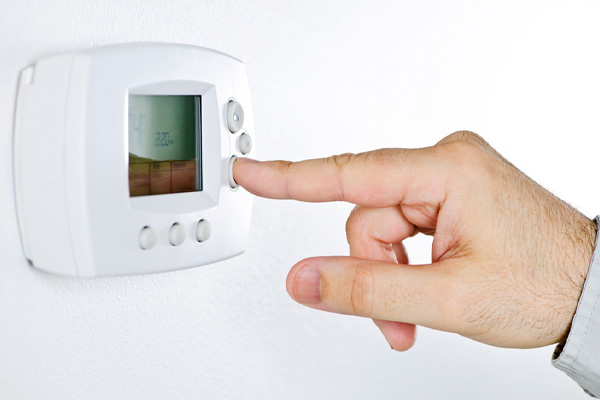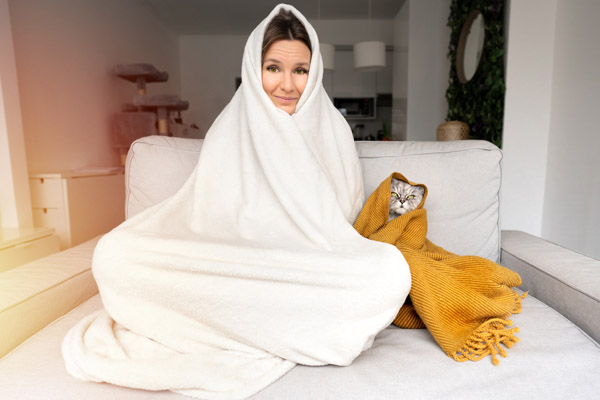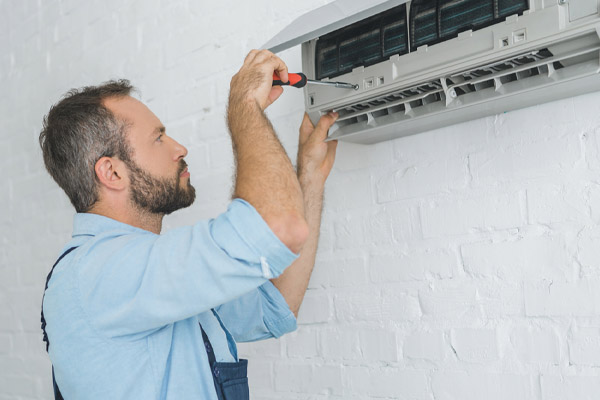Heat Pump: Using Auxiliary Heat vs Emergency Heat

In order to heat and cool your home with your heat pump, there is probably a thermostat on the wall to control the settings. Most people are familiar with the common Heat, Cool, as well as On and Off switches, but there are often other settings that may look strange or unfamiliar. These other heat pump settings may be for auxiliary heat and emergency heat. Homeowners often run across these settings on thermostats and some may do not know how they function. Here is more information on your heat pump’s auxiliary heat vs. emergency heat.
Auxiliary Heat Pump vs. Emergency Heat Pump Settings
Contents
- 1 Auxiliary Heat Pump vs. Emergency Heat Pump Settings
- 2 Call McAllister Energy To Learn More About Ductless HVAC Systems
Manufacturers use different labels when producing heat pumps. The most commonly used heat pump labels are ‘auxiliary’ and ’emergency’ heat settings. Both of these settings, essentially, function to provide additional heat.
There are two parts to most heat pumps:
- The outside unit (heat pump)
- Indoor unit (auxiliary heating system)
When the weather is relatively warm, the heat pump can warm the indoors by extracting the heat from inside to maintain an optimal temperature that is comfortable. When conditions are colder and freezing, the heat pump may not be able to provide enough heat. To provide the additional heat required, the auxiliary system function is used. The emergency heat function is a manual function and is operated when the heat pump has a problem.
Heat Pump Auxiliary Heat Explained
When there is insufficient heat outdoors to supply the heat pump, there is an additional function to keep indoor temperatures at a level that is comfortable. When the thermostat is in this mode, the heat pump will ensure that the desired temperature is reached by combining the outdoor heat that is already being pulled in with an additional secondary heat source. This combination effect helps boost the heat to the desired temperature. The additional heat is created in the heat pump using heating coils that are built into the unit.
When in auxiliary mode, the system will continue increasing the temperature level indoors until the secondary heat source is no longer needed. After the desired temperature level has been reached, the auxiliary heat setting will automatically shut off.
Heat Pump Emergency Heat Explained
As the name suggests, the heat pump emergency heat setting should only be used in the case of emergencies. For example, if a system has a malfunction, the emergency heat setting will be turned on automatically. When a problem with a heat pump occurs, there may not be enough time or a bad situation occurs when it is not possible for a technician to come out and do immediate repairs. More than likely, the homeowner will still require heat. During this period when a malfunction occurs, switching to the emergency heat mode can allow the heat pump to continue producing heat even when the heat pump is not functioning properly. When a heat pump is in emergency heat mode, it should be turned off once a technician arrives to diagnose and fix the problem.
Not Enough Heat Is Coming From the Heat Pump

There are circumstances when heat pumps fail and do not generate enough heat to properly warm a house. This failure occurs when the heat pump cannot reach the set temperatures on the thermostat. The auxiliary heat mode makes up for the difference and provides the extra amount of heating power needed to reach desired temperatures. The auxiliary system includes a function inside the heat pump using electric resistance heating. This system is automatically activated once the heat pump is in auxiliary mode.
Heat Pump Defrost Mode Explained
When there are low temperatures outside, ice can form and build up on the outside heat pump unit. When this buildup occurs, the unit can be switched to Defrost mode. During freezing weather, changing the system to defrost mode will force hot refrigerant to melt any ice that has built up on the unit. While in this mode, the heat pump will not produce heat for the house. While melting ice buildup in Defrost mode, the auxiliary heat function will activate to ensure that your home is continuously heated.
Defrost Mode Indicators
If your heat pump is in Defrost mode, you will be able to see the following:
- The outdoor heat pump will produce water or steam
- The unit fan will stop running
- There is a blinking light indicator (some models only)
How To Prevent The Auxiliary Heat Mode From Activating
During circumstances where there are extremely low temperatures, the heat pump system will overextend itself just to generate the required amount of heat needed to meet your heat pump settings. You do not want to punish your system during freezing conditions and cause unnecessary damages. Here are a few recommended changes to your home so that your heat pump can still function properly without activating the auxiliary heat mode.
Lower The Set Heating Temperature On The Thermostat

Oftentimes, the auxiliary heat mode is activated because the thermostat temperature is set too high. When the setting is too high, the auxiliary heat mode will kick on to compensate for the heat that is not generated by the heat pump. Your HVAC system does not need this kind of unnecessary stress. To avoid activating auxiliary mode, keep the temperature set between 62-68 degrees but no higher. By maintaining these temperature settings, your heat pump will continue to function well.
Create More Comfort
There are a few things you can do to help your heating system work better. During the daytime, draw the curtains or the blinds to allow light and heat indoors. Exterior windows and doors should be locked and closed to keep warm air inside. You can also consider alternatives to increasing the temperature on the thermostat by wearing thick or layered clothing.
Do Not Heat Unoccupied Rooms
If you have a zoned HVAC system, shut off the heat in certain rooms and areas where heating is not required. By doing so, you can heat desired places in your home where you need it. Areas of the house that are occupied the most can still remain warm and cozy while no energy is wasted heating rooms and areas that nobody is using.
The Auxiliary Settings Won’t Turn Off

During the cold winter months, you may sometimes find that your thermostat will remain in the auxiliary setting for extended periods of time. The reason is probably that your heat pump cannot generate the amount of heat needed to reach the desired temperature indoors and meet the demand for heating that your home requires. If you find that your system stays in Auxiliary mode too long, you may have to call a professional HVAC technician to come out and check your heat pump system. It could be likely that there are issues with your heat pump system or problems that arise from capacity or sizing.
Maintain Seasonally-Scheduled Heat Pump Tune-Ups
When it comes to annual HVAC maintenance checkups, this is a requirement that should never be ignored. Your system is more likely to function better and last longer when it is well-maintained. For most heat pumps, an inspection should be scheduled early before winter approaches. By doing so, any issues or damages to the system can be repaired including replacing any old or malfunctioning parts. This time also allows the HVAC technician to service the system so that any needed repairs are done, it is cleaned, and the air filters are replaced all before winter.
Conclusion
The winter months are when heat pumps work the hardest. There are several additional features built into heat pumps to ensure their reliability and function. However, it is important not to place too much stress on your heat pump when achieving your desired heating temperature. By maintaining your HVAC system regularly, your heat pump will always be ready to provide you with heat during the winter months.
Call McAllister Energy To Learn More About Ductless HVAC Systems

McAllister Energy provides the best cooling and heating services in the area. Our team consists of experienced certified technicians who can assist you with first-rate HVAC installations, repairs, tune-ups, and replacements. All of our technicians have years of experience and advanced knowledge to provide proper HVAC service.
McAllister Energy offers very competitive rates for HVAC services in the area. We can recommend the best HVAC replacement systems for you while staying within your budget. Our top priorities are comfort, indoor air quality, and energy efficiency, to name a few. Get in touch with McAllister Energy today for your free in-house estimate or to schedule an appointment.
You can click here to contact us now or call us at (856) 665-4545 to find out more!